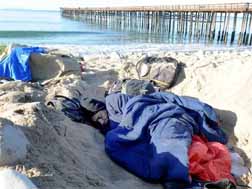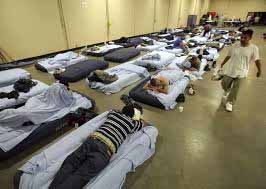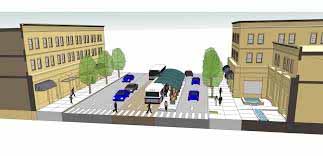Suggested Policies for Housing Chapter of Ventura County General Plan Update
These policy suggestions focus on serious justice issues regarding homelessness, lack of available affordable housing, and the intersection with water and climate policy and implications for 'community character'. We sought input from several design experts and a dozen advocates for the homeless and homeless people, but we have not had time to consult enough to say these represent more than our research. We do not intend that these suggestions conflict with the policy recommendations of the Ventura County Task Force on Housing or the organization Housing for All. They are a draft that we want to share because we did considerable work on it and we think there are some very important observations. Compiled by Jan Dietrick, Cindy Piester, with help of Kari Aist


GOAL A – Provide shelter for the homeless
POLICIES
- Call for State Declaration of Emergency on the county’s homeless crisis. Urge the Governor to declare the homeless crisis a state of emergency and ask for a concerted effort and resources to tackle this crisis in an effective manner.
- Fairness to those evicted. Survey discriminatory eviction practices and allow those evicted legal representation in court.
- Immediately and urgently establish four campgrounds, one in each of the four major geographic areas of Oxnard, Ventura, Thousand Oaks/Simi Valley, and Santa Clara Valley, no more than two miles from public transit corridors for immediate, unqualified use by homeless people and provide needed social services including at least one nutritious meal daily in an included community dining tent, and with provisions adequate to provide enough to eat for every individual present at the campground.
- Container homes. Fast track the development of a community of small container homes in each of the four major geographic areas of Oxnard, Ventura, Thousand Oaks/Simi Valley, and Santa Clara Valley, no more than two miles from public transit corridors, to provide immediate, unqualified transitional shelter for homeless people using a Housing First model to ensure shelter and then needed social services with a community garden and a small container kitchen for the provision of nutritious vegan food featuring locally and regeneratively grown produce.
- Small backyard houses. Assist homeowners to build small backyard houses, or upgrade illegally converted garages, if they agree to host a homeless person or family.
- Community land trusts. Support groups working to acquire successor parcels from development corporations to build collective housing that may include community gardens and other shared resources.
- Mentally ill homeless. Work with appropriate service providers to establish full time housing for those who are mentally ill.
- Mental Health Triage Services by the RISE program should include immediate housing assistance. RISE teams will be adequately staffed and supported to ensure housing for all homeless people as part of their case management.
- Continuum of Care by cities. Help to ensure a continuum of care and particularly assist City of Ventura to provide full time year round permanent shelter to house the homeless.
Prohibit criminalizing the mentally ill. Work with Criminal Justice System and Mental Health Services System to stop criminalizing the actions of the mentally ill. Join with Ventura Court Superior Judge Ryan Wright and the California State Judges Association, in calling on the State of California to provide adequate beds in California’s State Hospital system rather than allowing the mentally ill to languish in jails. - Citizen Oversight Committee. Create a Citizen Oversight Committee outside of the Sheriff’s Department to receive and review reports of harassment or other mistreatment of mentally ill and homeless people by law enforcement.
PROGRAMS
Housing First. A program in Utah demonstrated that public provision of free housing for the homeless is less expensive than the provision of services.The idea of Housing First is that housing comes first, services later. HUD estimates the annual cost of services for the homeless as between $30,000 and $50,000 per person. Housing costs a lot less than providing services. https://www.npr.org/2015/12/10/459100751/utah-reduced-chronic-homelessness-by-91-percent-heres-how
RISE delivers the county’s mental health triage services to connect services to people who had traditionally fallen through the cracks, including service-resistant and homeless populations. It does crisis prevention and crisis resolution services for lower level crises and coordinates with crisis teams for moderate to severe crisis response. RISE teams are assigned to each of the four major geographical regions – Oxnard, Ventura, Thousand Oaks/Simi Valley, and Santa Clara Valley and seek out clients where they live or congregate including shelters, community centers, libraries, parks, etc. in close partnerships with community service organizations, faith-based centers, and law enforcement in each region to maximize the effectiveness of outreach and engagement efforts. Rapid Response Assessment Teams staffed by Behavioral Health Clinicians are available to the East and West County to provide “quick strike.” Coordinators dedicated to homeless clients have been assigned to the two largest regional outpatient clinics in Ventura and Oxnard to ensure that the particular needs of these clients are addressed after they commence outpatient services.
JUSTIFICATION
Urgency is required to house the homeless. The increasing numbers of displaced homeless people (including the mentally ill homeless) and the lack of ongoing resources to stably re-house them require immediate and extraordinary action. There is no low income housing available, which necessitates the provision of campgrounds and container home communities that can be established immediately.
Criminalization of the mentally ill, who now fill our jails and prisons, began with the debacle of deinstitutionalization and is felt more than anywhere in our criminal justice system. With the closure of California’s State Hospitals, the cost shifting of care and treatment of vulnerable mentally ill populations to the counties, and the roadblocks to hospital admission by those who have been charged with crimes (even though the primary offense is mental illness) has resulted in the Counties carrying an unfair burden that should be borne by the State. http://correctionalnews.com/2017/08/29/ventura-county-jail-expansion-aid-mentally-ill-inmates/
GOAL B: Affordable housing for all.
POLICIES
- Housing Stock Occupancy Survey Do an in-depth survey to better understand and mitigate housing affordability and associated zoning issues
- Rent and Income Survey Conduct weighted surveys of rent and income in conjunction with the above Housing Stock Occupancy Survey that reveal how many adults are living in rental units in order to be able to afford the average rent and determine what percent of personal and family income is required for rental housing to understand how rent is calculated for workers trying to survive. Find out how housing stock is purposed, who is benefiting and who is suffering as a result.
Revise formula for Base Rent and how the policy is applied. To ensure equity and fairness across the county, examine the formula for determining Base Rent and the tax linkage for Investor/Owners who benefit from the Low Income Housing Credit Program. - Keep our housed population housed. Develop strategies that address critical affordability factors and homeless prevention.
- People with no income need a place to live. Stop just lowering the income limit that does not actually help the very poor who consequently remain homeless.
JUSTIFICATION
Ventura County critically needs affordable safe housing by people of all income levels including those with zero income as well as those in the lower middle income range between $30,000 and $60,000 a year. Housing here is a major justice issue, particularly for our disadvantaged communities.
An in-depth Housing Stock Occupancy Survey can be done in cooperation with all elected officials, perhaps aided by data from sources such as the census and Air BnB, to more accurately determine true vacancy rates. It is not clear, currently, what percentage of housing stock is actually owner occupied. Nor is it clear what percentage is investor owned and either sitting vacant as an investment or used as high end vacation rental property rather than for its properly zoned use as residential housing stock. The increase of high end investors profiting from our resources and directly impacting housing affordability puts budgetary stresses not just on residents, but also on the county and municipalities as they struggle to provide affordable housing without impacting farmland and density issues.
Vacancy rate surveys are currently done through a sample portion of the whole inventory and only with landlords who choose to participate, so there is no actual way to show that a significant number of housing units are sitting unoccupied for the purpose of profit investment and/or vacation rentals rather than for intended zoned purpose of residential housing.
Low vacancy rates stimulate the demand for expensive tax credit housing and regular market rate construction and also justify high rental and for sale prices which inflates affordability factors for ordinary working families, forcing them out of the area or leaving them at greater risk of homelessness. It is clear that investors stand to benefit by withholding inventory while the unnecessary and unreasonable burden this places on residents is ignored. This may explain Ventura County’s economic stagnation if adults are spending their money on rent and have no money left to buy goods and services.
The Base Rent Policy for a property is currently determined based upon the median income for the metropolitan Ventura County which is adjusted annually by HUD. This puts low income renters living in Oxnard and lower income areas at a tremendous and continuous disadvantage. Their base rate is determined and is frequently raised on the basis of the higher income wage earners, such as in Thousand Oaks and Westlake Village. This is not equitable or fair.
GOAL C: Publicly fund low-income housing as necessary to fully meet the need.
POLICIES
- Affordable housing ordinances. Adopt ordinances designed to increase the local stock of affordable housing, to ensure economically diverse housing developments to fully meet needs.
- Enforce 15-percent inclusionary requirement of affordable to lower- or moderate-income housing. Establish a formal policy of a 15-percent inclusionary requirement of affordable to lower- or moderate-income housing for all new developments of 15 units or more, rather than the payment of a fee in-lieu of meeting this requirement which the Board of Supervisors now allows on a case-by-case basis.
- Support mixed developments with enough low-income housing. Encourage mixed development to include units to address the need of low, very low, and extremely low income people near where people work; help ensure design and permitting to protect them from frivolous CEQA lawsuits lodged by wealthy interests.
- Public funding for housing. County will obtain the land and financing, then build and manage housing to fill the need for low, very low and extremely low income people.
JUSTIFICATION
Developers do not appear to be coming in with projects providing enough low income housing.
GOAL D: Ensure sufficient new and renovated housing near transit corridors and jobs to help workers make ends meet and to reduce Vehicle Miles Traveled.
POLICIES
- Eliminate side and front yard setbacks, so housing can be built to the sidewalk to use lots more efficiently.
- Commerce in residential areas. Allow markets, restaurants, and other neighborhood businesses to locate along major roads in residential areas.
- Mixed housing in shopping centers. Allow parking spaces in shopping centers to be converted to mixed housing that may be 3-5 stories and have elevators.
- Residential and commercial redevelopment on abandoned Zone M parcels. Encourage high-density redevelopment of “brownfields” or abandoned industrial land that is compatible with existing or expanded industrial activity.
- Priority of transit over roadways. Protect and increase transit service as a higher priority over building roadways and do not build roads out ahead of development.
- Enhance bikeways and footpaths. Encourage non-automobile travel through continuous feedback to meet needs of bicyclists and pedestrians.
GOAL E – Zoning will support housing in proximity to jobs and services
POLICIES
- Housing near job centers. Encourage developers to build housing near job centers to reduce vehicle miles traveled.
- Incentivize mixed-use development. Offer bonuses to developers that result in a diversity of housing units to address the needs of people who want to work and live in a local community.
- Farmworkers prefer housing in communities, not in buffer zones. No building of farmworker housing to be allowed in buffer zones. Prioritize new housing is built as infill and not on agricultural land, open space, or near polluting agricultural or industrial activity.
- Expand opportunities for residences co-located in commercial and industrial properties. Allow reasonable introduction or expansion of caretaker residence dwelling and needed employee housing on land zoned for commercial and industrial.
GOAL F – Eliminate blanket restrictions for height, square foot, layout, offsets, or functionality of buildings.
POLICIES
- Green Building Committee. Create a consultative body to develop policies that apply the latest knowledge and best practices to maximize energy and water efficiency and minimize pollution in communities.
- Education and engagement of neighborhood groups. Work with existing residents and neighborhood groups to learn about the benefits of situating development near transit, stores and services and to express how various options meet their needs.
- Taller buildings allowed that include elevators. Allow 3-6 story buildings in transit corridors with complete streets and mixed use to reduce use of cars and make sure that buildings have elevators for accomodation of mobility impaired people.
- Variety of housing types. Promote diversity by including a variety of housing types, unit sizes, rents and prices.
- Eliminate minimum off-street parking requirements. Establish minimum requirements with maximum parking spaces allows, and restrict single level parking facilities on grade.
- Livable streets. Make streets livable by adding stop signs and slowing traffic, and adding trees, plants, lights and signage.
- Accessory dwelling units. Encourage infill and building of Accessory Dwelling Units as authorized by California State Law on Jan 1, 2018.
- Allow community arrangements that may have private rooms or suites with shared kitchens, bathrooms, showers, storage and/or communal meeting space.
 GOAL G – Establish codes, performance characterization and incentives for zero net energy (ZNE) goals for all buildings.
GOAL G – Establish codes, performance characterization and incentives for zero net energy (ZNE) goals for all buildings.
POLICIES
- Prioritize plan-check and permitting for Zero Net Energy projects.
- Mandatory building disclosure and performance characterization. Benchmarking will be mandatory on larger buildings and evolve to incorporate a wider range of structures towards public disclosure of performance information and comparisons.
- Zero Net Energy targets for existing buildings. Identify increasingly aggressive performance targets for existing buildings and adapt energy codes to apply broadly and deeply to building alterations.
- Integrate building design at the community microgrid scale. To balance load in a part of the grid or microgrid, zoning and codes will specify features of that can be of value to the local grid infrastructure that assure a reliable and affordable grid.
- Make public and school buildings exemplary. Public buildings and schools will demonstrate options, viability, management strategies, market development, and credibility of Zero Net Energy policy, including costs and financing.
- Codify appliance standards where possible. To achieve Zero Net Energy standards, equipment and plug loads must be regulated.
GOAL H – Align incentives and codes with state regulations to minimize net water use for all new buildings.
POLICIES
- Reduce water demand. Equipment will meet EPA Water-Sense standards and landscaping will be designed to accommodate and thrive on rainfall and minimum irrigation.
- Produce alternative water sources. Provide incentives for building systems that harvest rainwater, stormwater, or sump-pump (foundation) water, greywater, refrigeration condensate, rejected water from water purification systems, reclaimed wastewater, and other reuse strategies.
- Allow wastewater treatment for reuse or injection to original water supply. Where possible, allow a closed loop water system within a watershed or aquifer that supplies water to the building and infiltrate stormwater to the original water supply.
- Stormwater retained on-site and infiltrated back to groundwater. Require low-impact development practices, also called green infrastructure, that use landscape features to minimize water loss due to runoff and allow water to infiltrate, which may include bioswales, rain gardens, and permeable pavement
PROGRAM
Net Zero Water Building Strategies Program Provide a clearinghouse of strategies for achieving a closed loop system for buildings where a water supply is located within the watershed or aquifer or where an alternative water supply can offset the use of freshwater.
GOAL I – Encourage building designs and materials for fire resistance.
POLICIES
- Allow non-standard fire-resistant designs. Streamline permitting for natural, fire-resistant building materials, including cob, adobe, rammed earth and wattle of existing sticks, or bamboo covered with a daub mixture of wet soil, clay, sand, animal dung and/or straw.
- Assure more preventive consultation about closing ducts where embers may enter and vegetation around homes that is not so flammable.
GOAL J – Assure fire protection and emergency services in rural and mountain areas.
GOAL K – Eliminate racist, discriminatory or otherwise unfair and illegal harassment, excessive force or brutality by sheriff deputies.
POLICIES
- Sheriff accountability and citizen review. Establish an outside Citizen Oversight Committee to receive and investigate allegations of harassment of the homeless, mentally ill, recovering alcoholics and drug users, women, youth or anyone based on their race, religion, sexual orientation, or economic status.
- Excessive use of force. Investigate incidents of significant use of force or police brutality for potential internal discipline.


